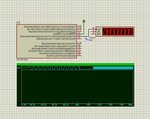victoramas
Junior Member level 1
I have tested it with PIC16F1825 at 32MHz internal clock.
At CLKOUT pin, OSC2, PORTA, RA4 it suppose to come a rectangular signal with a frequency Fosc/4=8MHz and is not there, the virtual digital oscilloscope does not show it.
I have tested the same HEX code on a real PIC16F1825 and I measured it with a real oscilloscope and I can see the 8MHz CLKOUT signal.
With Proteus I cannot simulate CLKOUT.
I asked directly on Proteus forum and the say is working and they provided the screenshot below, but without virtual oscilloscope and without showing how they did it, what setup and what code was used and they locked the question.
Any idea how they did it?
At CLKOUT pin, OSC2, PORTA, RA4 it suppose to come a rectangular signal with a frequency Fosc/4=8MHz and is not there, the virtual digital oscilloscope does not show it.
I have tested the same HEX code on a real PIC16F1825 and I measured it with a real oscilloscope and I can see the 8MHz CLKOUT signal.
With Proteus I cannot simulate CLKOUT.
I asked directly on Proteus forum and the say is working and they provided the screenshot below, but without virtual oscilloscope and without showing how they did it, what setup and what code was used and they locked the question.
Any idea how they did it?
